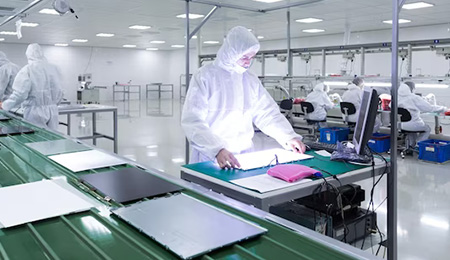
Liquid Crystal Display (LCD) technology remains a leading technique for creating visual displays in products. At its core, an LCD display consists of liquid crystals sandwiched between two polarized glass plates. By applying an electric current, these crystals can be rotated, which in turn changes the level of light transmitted by. This manipulation of light creates the images we see on our screens.
There are different categories of LCD display technologies: TN, which is known for its fast response time, and IPS, which offers better color accuracy. More recently VA technology has emerged, striking a balance between TN's speed and IPS's color performance.
Grasping LCD Panel Types
Liquid Crystal Display (LCD) panels are ubiquitous in modern electronics, powering everything from smartphones to televisions. While all LCDs share the fundamental principle of using liquid crystals to modulate light, there's a surprising variety of panel types available.
Each type employs distinct technologies and structures to achieve different performance characteristics. Some popular categories include TN panels, known for their fast response times but limited viewing angles, and IPS panels, offering superior shade accuracy and wider viewing angles. VA panels strike a compromise between performance, with good contrast ratios and fair viewing angles. Understanding these distinctions can help you choose the ideal LCD panel for your specific needs.
How LCD Displays Work: A Comprehensive Guide
LCD displays have revolutionized the way we interact with technology. From smartphones and laptops to televisions and monitors, these ubiquitous screens deliver vibrant images and sharp text. But how do they actually work? At their core, LCD displays utilize semiconductor materials sandwiched between two polarized glass panels. When an electrical current is applied to the liquid crystals, they reorient themselves, altering the passage of light and creating the pixels that form the image we see.
- This process involves intricate layers of emissive materials that control the flow of light from a backlight source.
- The strength of the electrical current determines the degree to which the liquid crystals block or allow light to pass through, resulting in varying shades of color and brightness.
- , Additionally , each pixel is composed of three subpixels—red, green, and blue—which blend to produce a wide spectrum of colors.
The complexity of LCD technology has led to significant advancements in display resolution, color accuracy, and energy efficiency. As our demands for visual clarity and immersive experiences continue to grow, LCD displays remain a cornerstone of modern electronics.
Advantages and Disadvantages of LCD Displays
LCD displays have become the ubiquitous standard in modern electronics, from smartphones to televisions. Their popularity stems from a combination of strengths. Firstly version.
By following these guidelines, you can maximize your LCD screen's refresh rate and enjoy a smoother,moreenjoyable viewing experience.
Connect Your LCD Display to Several Devices
A modern LCD display often serves as a central hub for a multitude of devices. Whether you're working on projects, connecting your LCD to various peripherals can enhance your experience. {Thankfully, most modern LCDs offer a selection of connection options. Common ports include HDMI, DisplayPort, VGA, and even USB-C. Determine the specific inputs available on your display and ensure your devices have matching outputs. You may need an adapter or converter to bridge compatibility gaps between different port types.
- {To successfully connect devices, you'll typically need toadjust the input source. This can often be done using a remote control or buttons on the side of the display itself.
- Once connected, your device's output signal will be displayed on the LCD screen. You may need to adjust settings such as resolution and refresh rate for optimal viewing.
Kinds of LCD Connectors and Cables
LCD displays rely on specialized connectors and cables to transmit graphic data from the source circuit to the screen itself. There are several common types of LCD connectors, each with its own characteristics. Some of the most prevalent include: LVDS, which is commonly used for notebook displays due to its high bandwidth and low power consumption. Another popular type is DVI, often found in desktop monitors, offering a wide range of resolution possibilities. HDMI is another versatile connector known for its ability to transmit both audio and video signals, making it a top choice for modern televisions and multimedia devices. For smaller displays, such as those found in mobile phones, you'll often see connectors lcd display like MHL.
Understanding the difference between these types of LCD connectors is crucial when purchasing a new display or equipment to ensure compatibility.
Designing with LCD Displays: Applications and Considerations
LCD displays offer a versatile platform for a wide range of applications. From personal electronics like smartphones and televisions to industrial equipment such as medical instruments, LCDs have become commonplace. When developing with LCD displays, several crucial considerations must be thoroughly addressed.
- Resolution and Pixel Density: The resolution and pixel density of an LCD display heavily impact the clarity and sharpness of the displayed image.
- Color Accuracy and Gamut: For applications where color accuracy is paramount, such as in graphic design, choosing an LCD with a broad color gamut is critical.
- Viewing Angle and Contrast Ratio: The viewing angle determines the range of angles from which the display can be viewed without noticeable degradation in image quality. A high contrast ratio enhances the depth and richness of displayed images.
Furthermore, factors like power consumption, refresh rate, and environmental resistance should also be meticulously evaluated during the design phase.
Looking ahead to of LCD Display Technology
While OLED technology has been making strides, LCD displays remain relevant. Manufacturers are directing resources towards {increasing theresolution of LCD panels, alongside improvements in color accuracy.{ The demand for thinner and lighter displays also drives innovation in LCD technology. Moreover, advancements in local dimming methods are helping to enhance contrast ratios, bridging the gap with higher-end display technologies. As the market evolve, LCD technology is poised to survive in a competitive landscape for years to come.
Sustainable Practices in LCD Manufacturing
The manufacturing of liquid crystal displays (LCDs) utilizes a intricate production system. To minimize the environmental impact, manufacturers are increasingly integrating sustainable practices throughout the complete lifecycle of LCDs. This includes decreasing energy expenditure, disposal hazardous substances responsibly, and supporting the use of repurposed materials.
- Many manufacturers are committing in renewable energy sources to supply their production facilities.
- Rigorous waste reduction systems are being established to minimize the generation of hazardous residues.
- Initiatives are underway to engineer LCDs that are more robust, reducing the need for frequent replacements.
Liquid Crystal Displays in Consumer Electronics
LCD panels have revolutionized the field of consumer electronics. Their flat design, excellent contrast ratios, and budget-friendly prices have made them the dominant choice for a wide range of devices. From smartphones to computers, LCD displays offer vibrant pictures and clear text, enhancing the user experience.
- The popularity of LCD technology is motivated by ongoing innovation, which frequently leads to enhanced performance and lower costs.
- Moreover, the eco-friendliness of LCD displays makes them a responsible choice for consumers who are aware of their environmental footprint.


Nevertheless, the future of consumer electronics may see a shift towards QLED displays, which potentially offer even higher image quality and intense colors.
Liquid Crystal Displays in Medical Diagnosis

LCD displays play a crucial/have a vital/serve an essential role in modern medical imaging. Their ability to display/capacity for displaying/skill in presenting high-resolution images with accurate/precise/clear detail is fundamental to/critical for/indispensable in diagnosing and monitoring/treating/managing a wide range of medical conditions/health issues/patient ailments. From X-ray imaging/ultrasonography/radiology, to MRI scans/CT scans/positron emission tomography (PET), LCD displays provide clinicians/offer radiologists/give physicians the visual insights/diagnostic tools/graphical representations necessary for effective/successful/accurate patient care.
- Furthermore/Additionally/Moreover, LCD displays are known for their/recognized for their/appreciated for their reliability/durability/robustness, which is essential/critical/paramount in a healthcare setting/medical environment/clinical facility.
LCD Displays in Automotive Systems
In modern automotive systems, LCD displays have become indispensable components for enhancing both driver control. These displays provide drivers with critical information, such as speed, fuel level, and navigation instructions. Moreover, LCD displays in vehicles are increasingly integrated with advanced functions, including entertainment systems, rear-view camera displays, and digital instrument panels. The growing demand for intuitive and interactive dashboards has driven the adoption of high-resolution LCD displays in automobiles.
Automotive LCDs are designed to operate reliably under harsh environmental conditions. They withstand temperature fluctuations, vibrations, and exposure to sunlight. Furthermore, advancements in display technology have resulted in improved contrast ratios, viewing angles, and response times. As the automotive industry continues to evolve, LCD displays will play an increasingly critical role in shaping the future of vehicle design and functionality.
Utilizing LCDs in Industry
Liquid crystal displays find extensive application in a diverse range of industrial applications. Their capabilities offer high resolution, low power usage, and a wide viewing angle. These factors make LCDs ideal for use in control panels across numerous industries.
In the manufacturing sector, LCD screens are utilized for real-time process monitoring. They allow operators to efficiently track and control settings, ensuring efficient production.

,Additionally LCDs are incorporated in industrial robotics for human-machine communications. These interfaces provide operators with clear information and allow for intuitive manipulation of complex systems.
The use of LCD screens in production settings has led to improved efficiency, performance, and safety. Their versatility makes them a valuable tool for modern industrial operations.